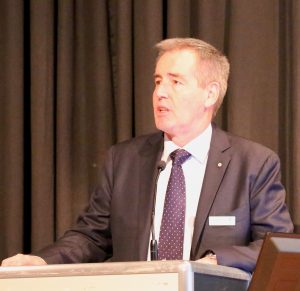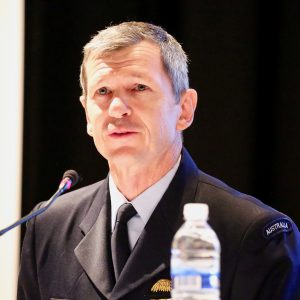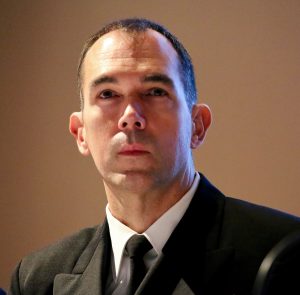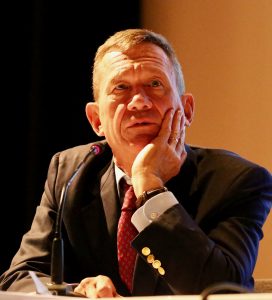2017-08-26 By Robbin Laird
On August 23, 2017, the Williams Foundation held a seminar on the future of electronic warfare.
With the introduction of the Growler, this has provided a natural hook into the broader discussion of the evolving payloads which need to be part of an integrated 21st century combat force.
The seminar background and focus was described in the run up to the seminar as follows:
An increasingly sophisticated and rapidly evolving threat with ready access to advanced, commercially available off-the-shelf technology is transforming the operational context in which the Australia Defence Force must now survive and fight.
 Air Marshal (Retired) Geoff Brown, Chairman, Williams Foundation
Air Marshal (Retired) Geoff Brown, Chairman, Williams Foundation
The next generation battlespace will be contested across multiple domains with control of the Electromagnetic Spectrum becoming just as important as control of the Air if the Joint Force is to operate with the freedom of manoeuvre necessary to ensure campaign success.
This Seminar seeks to build a common understanding of how the EA-18G Growler, in particular, will impact the Australian Defence Force at the strategic, operational and tactical levels, and how Airborne Electronic Attack is likely to shape future Australian Defence and Security policy.
It will provide a historical perspective on the development of the Royal Australian Air Force’s Electronic Warfare capability dating back to World War 2, and describe how today’s Air Force personnel are raising, training and sustaining the Growler Force in partnership with the United States Navy.
We will hear the perspectives of the Australian Army, Navy, and the Joint Commanders, as well as contributions from our senior coalition partners in the United States and the United Kingdom. The emphasis will be on gaining a better understanding of the key enablers and technologies, such as C4I, Electronic Warfare Battle Management, and training systems, which turn the manned and unmanned platforms into Joint Capability delivering sophisticated battlespace effects.
The Seminar will also serve as an opportunity to provide an industry perspective on Electronic Warfare and, in particular, the role they can play as a Fundamental Input to Capability. It will highlight the importance of disruptive technologies, speed to market, and the increasing emphasis on non-kinetic effects to gain operational advantage. Industry participants are invited to address topics including Electronic Warfare Battle Management, training, and the emerging technologies associated with networked, force level effects.
Above all, the seminar will emphasise the need for a new attitude to Electronic Warfare and, in particular, a need to embrace the arrival of the EA-18G Growler as a catalyst for change. In doing so, it provides an opportunity to make Electronic Warfare more accessible and understandable to the Joint Force, and develop the Information Age Warfighters necessary to deliver campaign success on future operations.
http://www.williamsfoundation.org.au/event-2527349
The Williams Seminars now for several years has been looking at the emergence and potential evolution of a fifth-generation combat force.
The most recent seminars have focused directly on shaping and integrated force; and the last one upon how to design an integrated force, rather than to simply shape after market platform integration.
The next seminars will address the challenges of transitioning and shaping a combat force able to operate in and prevail in high tempo operations up to and including high intensity warfare.
In effect, the recent seminar was a case study of the tron warfare piece of building an integrated force which can operate a variety of payloads in a diversity of conflict situations.
At first blush, the Growler and its integration was the focus of attention; but in reality, the seminar was much broader than that due to the focus of attention of the speakers and the interactions with the audience throughout the day.
 Group Captain Braz
Group Captain Braz
A report will be produced and along the way articles will be published on Second Line of Defense highlighting the seminar presentations.
In this piece, I simply want to give a sense of the day, rather than to provide detailed reportage on the comments, for that will come in the next few weeks.
The heart of the seminar was provided by a fascinating and wide ranging presentation by the RAAF and US Navy Growler participants.
The presentations highlighted the very flexible and innovative working relationship between the US Navy and the RAAF in delivering Growler to Australia.
This effort provides a model of how to deliver joint combat effects by an allied force.
But both highlighted, that Growler was in many ways a means to an end.
Group Captain Braz emphasized that the RAAF did not want stovepipe EW specialists but rather the delivery of EW or what we call Tron Warfare payloads in the battlespace.
 CDR Mike Paul
CDR Mike Paul
And even though the Aussies are just now getting Growler, the US Navy is just now working beyond the land wars to sort out how Growler fits into the high intensity battlespace.
And it is clear that the US Navy has much to learn from Australia, a point driven home by the US Navy representative, CDR Mike Paul, Electronic Attack ‘Wing, Pacific Fleet.
In an interview which I did with Group Captain Graz last Spring in Amberley, he highlighted how he saw the Aussie approach.
We need to get the experience which Growler can deliver and share the knowledge.
The difficult thing with Growler is that it delivers non-kinetic effects, and sometimes they’re difficult to measure. We’re used to being able to deliver effects through other systems where the outcome is tangible and measurable.
For a Growler, if you’re attacking a threat system or the people operating that threat system, then often it’s difficult to truly assess how much you’re affecting that system.
You can do trials and tests in certain scenarios, but it’s never quite the same, and so you get a level of confidence about what immediate effect you can achieve, but it’s the secondary and tertiary effects that we’re often looking for that are sometimes harder to measure.
The difficult challenge will become knowing how degraded the network is and how reliable the information is at any given point.
If you create enough uncertainty in the operators, then you can achieve an effect even if it’s not degraded.
Lt. General (Retired) Davis, recently the Deputy Commandant of Aviation, built from the core perspective of these two Tron Warriors to emphasize that for the USMC, electronic warfare capabilities are something which the insertion force needed as a core capability, not a specialized asset to be flown in from time to time.
He highlighted the Marine Corps approach to enabling the MAGTF with integrated EW capabilities, ranging from Intrepid Tiger pods on aircraft, to the F-35B, to the payloads on Blackjack, and to the coming new UAV which will be payload configurable.
The seminar organizer, John Conway, highlighted during the seminar and in talks after the seminar, the centrality of building EW into the operational art for the evolving combat force.
It is about reshaping the payloads which can be delivered by the integrated force across the spectrum of warfare.
The introduction of the Growler is an important jump start to Australian capabilities, but it comes into the force as the Aussies are working force integration hard.
This effort will inform how they use Growler and according to CDR Mike Paul will be very helpful as the US Navy transitions from a kill chain to a kill web focus.
In short, the seminar provided a case study of shaping a way ahead for broadening the capability which the evolving 21st century combat force can deliver.
 Lt. General (Retired) Jon Davis
Lt. General (Retired) Jon Davis
And as Lt. General (Retired) Davis put it with regard to the Williams Foundation contribution:
“Hats off to the Williams Foundation for what you do.
“You provide a venue where you can share your ideas, be challenged, and to do so in a joint community.
“And it is done in public so can inform a broader discussion.”


